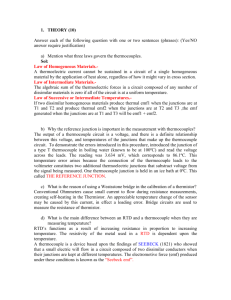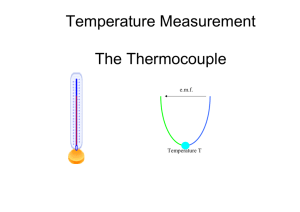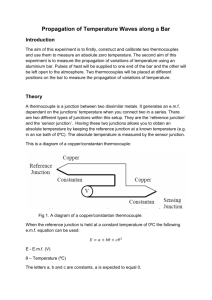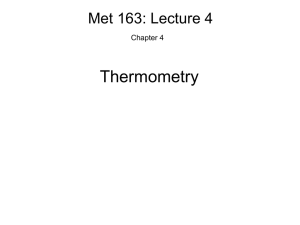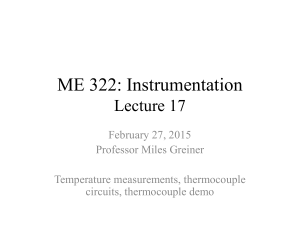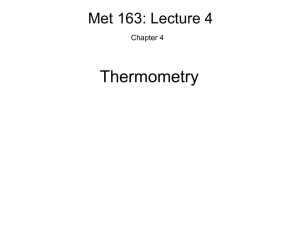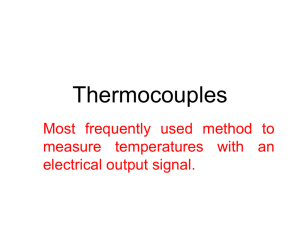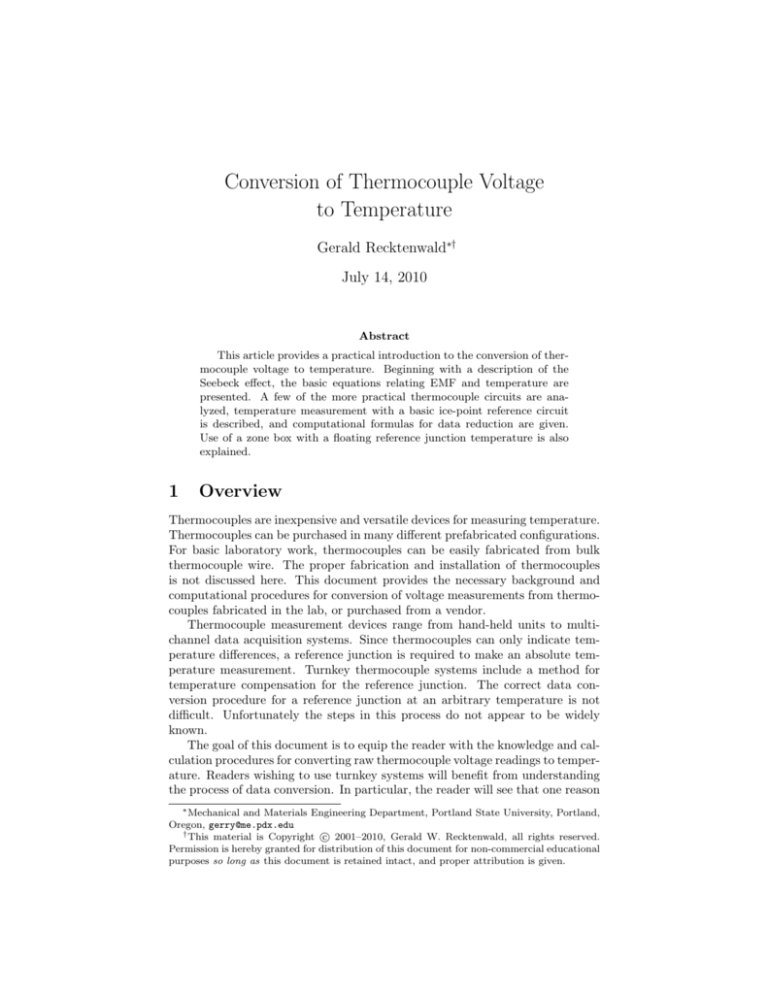
Conversion of Thermocouple Voltage
to Temperature
Gerald Recktenwald∗†
July 14, 2010
Abstract
This article provides a practical introduction to the conversion of thermocouple voltage to temperature. Beginning with a description of the
Seebeck effect, the basic equations relating EMF and temperature are
presented. A few of the more practical thermocouple circuits are analyzed, temperature measurement with a basic ice-point reference circuit
is described, and computational formulas for data reduction are given.
Use of a zone box with a floating reference junction temperature is also
explained.
1
Overview
Thermocouples are inexpensive and versatile devices for measuring temperature.
Thermocouples can be purchased in many different prefabricated configurations.
For basic laboratory work, thermocouples can be easily fabricated from bulk
thermocouple wire. The proper fabrication and installation of thermocouples
is not discussed here. This document provides the necessary background and
computational procedures for conversion of voltage measurements from thermocouples fabricated in the lab, or purchased from a vendor.
Thermocouple measurement devices range from hand-held units to multichannel data acquisition systems. Since thermocouples can only indicate temperature differences, a reference junction is required to make an absolute temperature measurement. Turnkey thermocouple systems include a method for
temperature compensation for the reference junction. The correct data conversion procedure for a reference junction at an arbitrary temperature is not
difficult. Unfortunately the steps in this process do not appear to be widely
known.
The goal of this document is to equip the reader with the knowledge and calculation procedures for converting raw thermocouple voltage readings to temperature. Readers wishing to use turnkey systems will benefit from understanding
the process of data conversion. In particular, the reader will see that one reason
∗ Mechanical
and Materials Engineering Department, Portland State University, Portland,
Oregon, gerry@me.pdx.edu
† This material is Copyright c 2001–2010, Gerald W. Recktenwald, all rights reserved.
Permission is hereby granted for distribution of this document for non-commercial educational
purposes so long as this document is retained intact, and proper attribution is given.
2
PHYSICS OF THERMOCOUPLES
2
for uncertainties associated with thermocouple temperature measurement is the
lack of control over the reference junction temperature in turnkey systems. It
is easy to construct a zone box that maintains the reference junction(s) at a
uniform temperature, and thereby achieve more accurate temperature measurement than is possible with most turnkey systems.
2
Physics of Thermocouples
The equations necessary for the practical use of thermocouples are derived from
the basic definition of the Seebeck Effect. This information is extracted from
Chapter 2 of A Manual on the Use of Thermocouples in Temperature Measurement by the American Society for Testing and Materials [1]. Anyone using
thermocouples would benefit from studying the ASTM manual.
2.1
The Seebeck Effect
Electrically conductive materials exhibit three types of thermoelectric phenomena: the Seebeck effect, the Thompson effect, and the Peltier effect. The Seebeck
effect is manifest as a voltage potential that occurs when there is a temperature
gradient along the length of a conductor. This temperature-induced electrical
potential is called an electromotive force and abbreviated as EMF.
The macroscopic manifestation of EMF is due to the rearrangement of the
free electrons in the conductor. When the temperature and all other environmental variables that might affect the wire are uniform, the most probable
distribution of the free electrons is uniform. The presence of a temperature
gradient causes a redistribution of the free electrons, which results in a nonuniform distribution of the electric charge on the conductor. Above submicron
length scales, the charge distribution does not depend on the geometry, e.g.
cross-section shape or length, of the conductor. As a practical consequence of
the charge distribution, the conductor exhibits a variation of voltage potential
(the EMF) that is directly related to the temperature gradient imposed on the
conductor. Because the EMF is uniquely related to the temperature gradient,
the Seebeck effect can be used to measure temperature.
Figure 1 represents a conceptual experiment that exhibits the Seebeck effect.
The two ends of a conducting wire are held at two different temperatures T1
and T2 . For clarity, assume that T2 > T1 , although with appropriate changes of
sign, the development that follows is also applicable to the case where T2 < T1 .
If the probes of an ideal voltmeter could be connected to the two ends of the
wire without disturbing the temperature or voltage potential of the wire, the
voltmeter would indicate a voltage difference on the order of 10−5 volts per
degree Celsius of temperature difference. The relationship between the EMF
and the temperature difference can be represented as
E12 = σ̄(T2 − T1 )
(1)
where σ̄ is the average Seebeck coefficient for the wire material over the temperature range T1 ≤ T ≤ T2 .
The voltmeter in Figure 1 is imaginary because the copper leads of the
voltmeter probe also exhibit the Seebeck effect. If the leads of the voltmeter
2
PHYSICS OF THERMOCOUPLES
3
T2
E12
Voltmeter
T1
Figure 1: A conceptual experiment to exhibit the Seebeck effect in a wire with
end temperatures T1 and T2 . The dashed boxes represent local environments at
uniform temperatures. The open circles are the ends of the measuring probes of
the ideal voltmeter that can detect the voltage potential E12 without actually
touching the ends of the wire. The solid circles are the ends of the wire.
were connected to the wire, the voltage indicated by the voltmeter would be
the combined potential due to the Seebeck effect in the wire sample and the
Seebeck effect in the probe leads. Thus, the circuit in Figure 1 is not practical
for measuring temperature.
The Seebeck coefficient is a property of the wire material. The value of σ̄
does not depend on the length, diameter, or any other geometrical feature of the
conductor wire. On the other hand, the Seebeck coefficient of a given material
can be effected by oxidation or reduction of the conductor material, or by plastic
strain of the conductor.
In general, the Seebeck coefficient is a function of temperature. To develop
a more precise and versatile relationship than Equation (1), consider an experiment where T1 is fixed, and T2 is varied. For practical thermocouple materials
the relationship between E and T is continuous. Hence, for sufficiently small
change ∆T2 in T2 , the EMF indicated by the voltmeter will change by a corresponding small amount ∆E12 . Since ∆T2 and ∆E12 are small, it is reasonable
to linearize the EMF response as
E12 + ∆E12 = σ̄(T2 − T1 ) + σ(T2 )∆T2
(2)
where σ(T2 ) is the value of the Seebeck coefficient at T2 . The change in EMF
only depends on the value of the Seebeck coefficient at T2 because T1 is held
fixed. Subtract Equation (1) from Equation (2) to get
∆E12 = σ(T2 )∆T2
(3)
which can be rearranged as
∆E12
(4)
∆T2
If σ is an intrinsic property of the material, then the preceding equation must
hold for any temperature. Replacing all references to T2 with an arbitrary
temperature T , and taking the limit as the temperature perturbation goes to
zero, gives
∆E
σ(T ) = lim
(5)
∆T →0 ∆T
σ(T2 ) =
2
PHYSICS OF THERMOCOUPLES
4
x
Tt
material A
Tj
Voltmeter
material B
Figure 2: A simple thermocouple.
Using the Fundamental Theorem of Calculus, the limit becomes a derivative.
The result is the general definition of the Seebeck Coefficient
σ(T ) =
dE
dT
(6)
Equation (6) contains all the theoretical information necessary to analyze thermocouple circuits.
2.2
EMF Relationships for Thermocouples
The wire depicted in Figure 1 is not directly useful for measuring temperature.
For the situation in Figure 1, the voltmeter probes also experience a temperature
gradient. The probes are made of Copper wire, and Copper has a Seebeck
coefficient comparable with other metals used to make thermocouples. Thus,
unless both ends of each probe wire are at the same temperature, the probes
themselves will contribute an additional EMF to the circuit. In other words,
although one might imagine the measurement of the EMF for a single wire, it
is not feasible to do so in practice.
Practical exploitation of the Seebeck effect to measure temperature requires
a combination of two wires with dissimilar Seebeck coefficients. The name
thermocouple reflects the reality that wires with two different compositions are
combined to form a thermocouple circuit. Figure 2 represents such a basic
thermocouple. The two wires of the thermocouple are joined at one end called
the junction, which is represented by the solid dot on the right side of Figure 2.
The junction is in thermal equilibrium with a local environment at temperature
Tj . The other ends of the thermocouple wires are attached to the terminals of
a voltmeter. The voltmeter terminals are both in thermal equilibrium with a
local environment at temperature Tt .
Equation (6) is applied to the thermocouple circuit in Figure 2 by writing
dE = σ(T ) dT
(7)
Thus, the EMF generated in material A between the junction at Tt and the
junction at Tj is
Z Tj
EA,tj =
σA (T )dT
(8)
Tt
Applying Equation (8) to consecutive segments of the circuit gives
Z Tj
Z Tt
EAB =
σA dT +
σB dT
Tt
Tj
(9)
2
PHYSICS OF THERMOCOUPLES
5
where σA is the absolute Seebeck coefficient of material A, and σB is the absolute
Seebeck coefficient of material B. The order of integration is specified by moving
continuously around the loop: from the terminal to the junction, and back to
the terminal.
The position of the junction around the thermocouple circuit is identified
by the x coordinate in Figure 2. For the purpose of analyzing thermocouple
circuits, the physical length of wire is immaterial. Accordingly, x should be
thought of an indicator of position only, not a measure of distance.
Notice that the value of EAB in Equation (9) is due to integrals along the
length of the thermocouple elements. This leads to the following essential and
often misunderstood fact of thermocouple thermometry:
The EMF generated by the Seebeck effect is due to the
temperature gradient along the wire. The EMF is not generated at the junction between two dissimilar wires.
The thermocouple junction performs two essential roles.
• The junction provides electrical continuity between the two legs of the
thermocouple.
• The junction provides a heat conduction path that helps to maintain the
ends of the two dissimilar wires at the same temperature (Tj ).
The EMF of the thermocouple exists because there is a temperature difference
between the junction at Tj and the open circuit measuring terminals at Tt .
Switching the order of the limits for the second integral in Equation (9)
allows the following manipulation
Z
Tj
Z
Tj
Z
σA dT −
EAB =
Tt
Tj
(σA − σB ) dT
σB dT =
Tt
(10)
Tt
Now define the Seebeck coefficient for the material pair AB as
σAB = σA − σB
(11)
If the two materials have the same absolute Seebeck coefficients, i.e. if σA =
σB , then the thermocouple generates no EMF, regardless of the temperature
difference Tj − Tt . There are standard combinations of materials that provide
large values of σAB that are slowly varying with T .
Substituting the definition of σAB into Equation (10) gives
Z
Tj
EAB =
σAB dT
(12)
Tt
Equation (12) is the fundamental equation for the analysis of thermocouple
circuits. It is not yet in the form of a computational formula for data reduction.
Indeed, conversion of thermocouple EMF to temperature does not require the
evaluation of integrals. Before a data reduction formula can be developed,
however, the role of the reference junction needs to be clarified.
2
PHYSICS OF THERMOCOUPLES
6
Physical Circuit:
x
Tr
Tt
Voltmeter
1
Cu
2
5
Cu
4
material P
Tj
3
material N
Conceptual T(x) Plot:
3
Ejr
emf relative
to reference
junction
rial N
mate
mate
rial P
Tj
1
Tt
5
Cu
Tr
Etr
Cu
2
4
0
x
Figure 3: A thermocouple with a reference junction. The upper portion of the
diagram represents the physical arrangement of the wires in the circuit. The
lower portion of the diagram is a conceptual representation of the relationship
between temperature and EMF along the wires.
2.3
Reference Junction
Equation (12) shows how the EMF generated by a thermocouple depends on
the temperature difference between the Tj and Tt . All thermocouple circuits
measure one temperature relative to another. The only way to obtain the absolute1 temperature of a junction is to arrange the thermocouple circuit so that it
measures Tj relative to an independently known temperature. The known temperature is referred to as the reference temperature Tr . A second thermocouple
junction, called the reference junction, is located in an environment at Tr .
Figure 3 shows a thermocouple circuit with a reference junction at temperature Tr . The case of Tr < Tt is depicted, but the analysis of the circuit EMF
also works with Tr ≥ Tt . At the reference junction, copper extension wires connect the voltmeter to the legs of the thermocouple. The thermocouple wires are
labelled P for positive and N for negative. Beginning with the terminal block at
temperature Tt , there are five junctions around the circuit. Using x as a position
1 Here “absolute” means not being relative to another temperature in the circuit, not necessarily a thermodynamic absolute temperature.
2
PHYSICS OF THERMOCOUPLES
7
indicator, the five labelled junctions are numbered in order of increasing x.
The lower half of Figure 3 is a schematic representation of the thermocouple
circuit. The horizontal axis is the position x. The left vertical axis is the temperature. The right vertical axis is the EMF relative to the reference junction.
The scale of the EMF axis applies only to the P and N legs of the thermocouple,
not the copper extension wires.
To find the EMF produced by the thermocouple circuit in Figure 3, apply
Equation (8) to each segment of wire in the circuit
Z Tt
Z Tr
Z Tj
Z Tr
σC dT
(13)
σN dT +
σP dT +
σC dT +
E15 =
Tj
Tr
Tt
Tr
where σC is the absolute Seebeck coefficient of copper, σP is the absolute Seebeck
coefficient of the material in the positive leg, and σN is the absolute Seebeck
coefficient of the material in the negative leg. Reversing the limits of integration
for the first term in Equation (13) gives
Z Tr
Z Tt
σC dT = −
σC dT
(14)
Tt
Tr
Therefore, the first and last terms in Equation (13) cancel. Furthermore, reversing the limits of integration in the third term in Equation (13) and simplifying
yields
Z Tj
σP N dT
(15)
E15 =
Tr
where σP N = σP − σN .
The result in Equation (15) can be interpreted graphically with the lower
half of Figure 3. The EMF across the copper segments 1-2 and 4-5 cancel
because the EMF on these segments is of equal magnitude and opposite sign.
Think of going down in potential from 1 to 2, and up in potential from 4 to
5. The EMF across segments 2-3 and 3-4 does not cancel, however, because
the absolute Seebeck coefficients for these two segments are not equal. Indeed,
a thermocouple is only possible when two dissimilar wires are joined so that
σP N = σP − σN 6= 0.
The circuit in Figure 3 provides a practical means for measuring temperature
Tj relative to temperature Tr . To use this circuit an independent method of
measuring Tr is required, along with the value of σP N .
2.4
Standard Calibration Curves
The ASTM identifies eight standard types of thermocouples. The nominal compositions of the positive (P) and negative (N) elements for these standard thermocouples are listed in Table 1 in Appendix A. For each of the standard thermocouple types, references [1] and [2] provide calibration tables and polynomial
curve fit coefficients for those tables. The calibration tables and equations use
Equation (15) with a reference temperature of 0 ◦C, which is easily obtainable
with a mixture of ice and water.
The integral in Equation (15) is a formal statement of the relationship between EMF on temperature. To develop a calibration for a particular thermocouple type, the EMF is measured as Tj is varied and Tr is held fixed at 0 ◦C.
3
PRACTICAL THERMOCOUPLE CIRCUITS
Tt
Cu
material P
Cu
material N
Voltmeter
8
Tj
Tr
Figure 4: A thermocouple with an ice-point reference junction for both the P
and N leads. The two reference junctions are placed in the same ice bath and
are electrically isolated from each other.
The result of the calibration is a table of EMF versus T values. The integral is
never directly evaluated. Instead a polynomial curve fit to the calibration data
gives
E0j = F (Tj ) = b0 + b1 Tj + b2 Tj2 + . . . + bn Tjn
(16)
R Tj
In terms of the formalism of the preceding sections, E0j = 0 σP N dT . From
the same calibration data a curve fit of the form
2
m
Tj = G(E0j ) = c0 + c1 E0j + c2 E0j
+ . . . + cm E0j
(17)
is also obtained. The F (Tj ) and G(E0j ) symbols provide convenient shorthand
notation for the two calibration polynomials. Equation (17) is directly useful for
temperature measurements with thermocouples. For the circuit in Figure 3, with
Tr = 0, Equation (17) allows a measured EMF to be converted to a temperature.
The coefficients of the calibration equations for type J thermocouples are
given in Table 2 through Table 5 in Appendix A. Similar calibration data for
other standard thermocouples are provided in [1, 2].
3
Practical Thermocouple Circuits
The equations in the preceding sections are now applied to develop thermocouple
circuits that can be used in a laboratory. The following topics are covered.
• Compensation with a reference junction in an ice bath;
• Compensation with a reference junction at an arbitrary temperature;
• Use of zone boxes for large numbers of thermocouples.
3.1
Ice-Bath Reference Junctions
Figure 3 depicts a useful thermocouple circuit. The most straightforward implementation of this circuit is to place the reference junctions (block labelled Tr )
in an ice bath. The resulting circuit is sketched in Figure 4. The two junctions
can share the same ice bath if they are electrically insulated from each other2 .
2 Refer
to [1] for the recommended construction of an ice bath.
3
PRACTICAL THERMOCOUPLE CIRCUITS
9
For the thermocouple circuit in Figure 4, the standard calibration equations are
used directly.
An alternative circuit with an ice bath reference is shown in Figure 5. The
isothermal zone labelled Tb is a connector block where the lead wires are connected to the P and N legs of the thermocouple. A single junction is located in
the ice bath. The connector block has two junctions between the copper extension wires and two separate P elements, one for each leg of the thermocouple.
Applying Equation (8) to each segment of wire in the circuit gives
Z
Tb
Z
Tj
Z
Tb
Z
Tr
Tj
Tt
σC dT
σP dT +
σN dT +
Tb
Tt
Tr
σP dT + +
σC dT +
E16 =
Z
Tb
The first and last integrals cancel, (Cf. Equation (14).) Rearranging the remaining terms gives
Z Tb
Z Tj
Z Tr
σN dT
σP dT +
σP dT +
E16 =
Tb
Tr
Z
Tj
Z
Tj
σP dT −
=
Tr
Z
Tj
σN dT
Tr
Tj
=
σP N dT
Tr
Since Tr = 0 (the standard reference temperature), Equations (16) and (17)
may be used directly for the thermocouple circuit in Figure 5.
Example 1: Conversion of Thermocouple EMF to Temperature
A type J thermocouple is used to create the circuit in Figure 5. If the
measured output is 4.10 mV, what is the temperature of the thermocouple
junction?
The temperature is obtained by evaluating Equation (17) with the ci
coefficients from Table 3.
T = G(E0j ) = 1.978425 × 101 (4.1) − 2.001204 × 10−1 (4.1)2
+ 1.036969 × 10−2 (4.1)3 − 2.549687 × 10−4 (4.1)4
+ 3.585153 × 10−6 (4.1)5 − 5.344285 × 10−8 (4.1)6
+ 5.099890 × 10−10 (4.1)7
=
78.4◦C
2
3.2
Reference Junction at Arbitrary Temperature
Although the standard calibration equations are for a reference junction at 0 ◦C,
thermocouple circuits with reference junctions at arbitrary temperatures provide
considerable convenience and flexibility. The reference junction still needs to
be measured independently, for example, with a thermistor. In this type of
thermocouple circuit, the reference junction is usually placed in a protected
PRACTICAL THERMOCOUPLE CIRCUITS
Physical Circuit:
x
Tt
Voltmeter
10
Tb
1
Cu
2
6
Cu
5
material P
material P
3
Tr
4
ice point
reference
Conceptual T(x) Plot:
3
Cu
Ejr
rial N
mate
mate
rial P
Tj
Tb
Tt
Tj
material N
5
2
1
4
Tr
mate
rial P
3
x
emf relative
to reference
junction
Cu
6
Etr
0
Figure 5: A thermocouple with an ice-point reference junction for just the N
lead.
environment so that its temperature varies only slowly. The temperature of
the measurement junction is then obtained by accounting for the difference
between the actual reference junction temperature and the reference junction
temperature for which the thermocouple was calibrated.
Reconsider the thermocouple circuit in Figure 3. Suppose that there is some
independent method for determining Tr and that Tr 6= 0. This situation is
depicted in Figure 6. The T symbol indicates a temperature sensor that is
used to measure Tr . Equation (15) still applies, but since Tr 6= 0, the standard
thermocouple calibration data cannot be applied directly.
Let Erj be the EMF due to the temperature difference between Tr and Tj .
Z
Tj
Erj = E15 =
σP N dT
Tr
In other words, Erj is the EMF generated by the thermocouple circuit with its
RT
reference junction at Tr 6= 0. Add and subtract 0 r σP N dT from the right hand
3
PRACTICAL THERMOCOUPLE CIRCUITS
11
Physical Circuit:
Tr
Tt
Voltmeter
1
Cu
2
5
Cu
4
material P
Tj
3
material N
T
Conceptual T(x) Plot:
3
Tr
Tt
2
Cu
rial N
mate
mate
rial P
Tj
4
Ejr
E0j
Cu
1
5
E0r
x
Figure 6: Thermocouple circuit with and arbitrary, but known, reference junction.
side of the preceding expression to get
Z Tj
Z Tr
Z
Erj =
σP N dT +
σP N dT −
Tr
Z
0
Tj
Tr
Z
0
For convenience, define
Z Tj
E0j =
σP N dT,
σP N dT
0
σP N dT −
=
Tr
σP N dT
(18)
0
Z
and
0
E0r =
Tr
σP N dT.
(19)
0
E0j is the EMF of a thermocouple with its reference junction at 0 ◦C and its
measuring junction at Tj . E0r is the EMF of a thermocouple with its reference
junction at 0 ◦C and its measuring junction at Tr . These EMF values are
depicted in the right half of the T (x) plot in Figure 6. With these definitions,
Equation (18) is equivalent to
Erj = E0j − E0r
or
E0j = Erj + E0r
(20)
3
PRACTICAL THERMOCOUPLE CIRCUITS
12
Erj is the output of the thermocouple circuit in Figure 6. Erj is known because
it is measured. E0r is not measured, but it can be computed from Equation (16)
if Tr is known. Given the measured value of Erj and the computed value of E0r ,
the value of E0j is calculated from Equation (20). Finally, the temperature of
the junction is computed with Equation (17).
Summary: The following steps are used to compute the temperature of a
thermocouple with a reference junction at an arbitrary temperature Tr :
1. Measure Erj , the EMF of a thermocouple with its reference junction at
Tr and its measuring junction at Tj .
2. Measure Tr with some device such as an ice-point compensated thermocouple, a thermistor, or a solid state temperature sensor.
3. Compute E0r = F (Tr ), the EMF of an ice-point compensated thermocouple at temperature Tr .
4. Compute E0j = Erj + E0r , the EMF of an ice-point compensated thermocouple at Tj .
5. Compute Tj = G(E0j ) from the ice-point calibration data for the thermocouple.
Example 2: Thermocouple with a Floating Reference Junction
A type J thermocouple is used to create the circuit in Figure 6. The reference temperature is Tr = 21.23◦C and the thermocouple EMF (relative
to the reference temperature) is Erj = 1.672 mV. What is the temperature of the thermocouple junction?
The EMF of an ice-point compensated thermocouple at Tr would be
(using the polynomial coefficients from Table 2).
E0r = F (21.23◦C) = 1.0825 mV
If the measuring junction was referenced to an ice-bath, its EMF would
be
E0j = 1.6721 + 1.0825 = 2.7546 mV
Now, using the ice-point calibration data, compute Tj
Tj = G(2.7546 mV) = 53.18◦C.
2
3.3
Use of a Zone Box for Multiple Thermocouples
The basic ice-point reference circuit in Figure 5 can in principle be replicated
when two or more temperatures need to be measured. Fabricating and maintaining multiple ice-point junctions is tedious, however. For multiple temperature measurements, a zone box provides a more convenient and reliable device
for controlling the reference junction temperature. A zone box is an insulated
container that maintains one or more thermocouple junctions at a uniform temperature. The zone box does not (usually) have an active temperature control.
3
PRACTICAL THERMOCOUPLE CIRCUITS
Tt
13
Tc
Tr
1
Cu
2
Cu
3
material P
7
Cu
6
Cu
5
material N
4 T
j1
Cu
Tj2
Cu
8
9
Cu
10
14
13
Cu
12
Voltmeter
multiplexer
zone
box
connector
Tr
11
ice point
reference
Figure 7: A zone box with an ice-point reference junction.
It just a isolated environment with a stable and measurable temperature. A
simple type of zone box construction is described in § 4.
Figure 7 shows one possible zone box circuit. A single ice-point reference
is provided for several measurement junctions Tj1 , Tj2 , etc. The measurement
junctions are placed wherever temperature measurements need to be made. The
ice-point junction is placed in a convenient location near the zone box.
The multiplexer and connector are not part of the zone box. A connector,
if present in the circuit, allows the data collection instruments (the multiplexer
and voltmeter) to be disconnected from the thermocouple circuit when the experimental apparatus is not being used. The multiplexer is a series of switches
that connect one thermocouple junction at a time to the voltmeter. Often, the
multiplexer and voltmeter are combined into a single instrument.
The ice-bath thermocouple for the circuit in Figure 7 provides the reference
junction EMF for all measurement junctions attached to the multiplexer through
the zone box. To see how the data reduction procedure works, consider the
conversion of the EMF from the first measuring junction. The EMF at the
multiplexer for the first thermocouple is
Z
Tc
Erj,1 = E17 =
Z
Tr
σC dT +
Tt
σC dT
Tc
Z
Tj
+
σP N dT
Tr
Z
Tc
+
Z
Tt
σC dT +
Tr
σC dT
Tc
In the right hand side of this equation, the EMF contributions on the first and
3
PRACTICAL THERMOCOUPLE CIRCUITS
14
third lines cancel, so
Z
Tj
Erj,1 =
σP N dT.
(21)
Tr
Similarly, the EMF at the multiplexer for the thermocouple in the ice bath is
Z 0
σP N dT
(22)
Er0 = E8−14 =
Tr
where the equal and opposite EMFs from the extension wires has already been
cancelled.
Now, suppose that instead of the circuit in Figure 7, the temperature at Tj,1
was measured with a thermocouple having an ice-bath reference junction. The
EMF output of that thermocouple would be
Z
E0j,1 =
Tj1
σP N dT.
0
Writing the preceding integral as the sum of two integrals gives
Z
E0j,1 =
Tr
Z
Tj1
σP N dT +
0
σP N dT.
(23)
Tr
Substituting Equations (21) and (22) into Equation (23) gives
E0j,1 = −Er0 + Erj,1 .
(24)
Therefore, by combining the two electrical measurements of Er0 and Erj,1 , the
effective EMF of a thermocouple with a reference junction at 0 ◦C is obtained.
The connector is idealized as a single point where two wires are joined.
In practice a standard electrical connector, e.g. a DB-25 or DB-50 computer
communication connector, is used. One must be aware that standard electrical
connectors might involve dissimilar metals along the signal path. As long as the
temperature of the connector is uniform, however, the dissimilar metals will not
introduce a measurement error.
Summary: The following steps are used to compute the temperatures of the
measuring junctions in Figure 7:
1. Measure Er0 , Erj,1 , Erj,2 , . . .
2. For each measuring junction, compute
E0j,i = Erj,i − Er0
i = 1, . . . , n
where n is the total number of measuring junctions.
3. Use the thermocouple tables, or Equation (17) to compute the temperature of each junction Tji from E0j,i .
3
PRACTICAL THERMOCOUPLE CIRCUITS
Tt
Tc
15
Tr
1
Cu
2
Cu
3
material P
7
Cu
6
Cu
5
material N
4 T
j1
Cu
Tj2
Cu
Cu
Voltmeter
Cu
multiplexer
connector
RT
zone
box
Figure 8: A zone box with a thermistor to measure Tr . Note that the thermistor
reading requires a multimeter that can measure resistance.
3.4
Measuring Zone Box Temperature with a Thermistor
The zone box circuit in Figure 7 requires maintenance of an ice bath reference for
determining the reference junction temperature. The ice bath can be eliminated
if Tr is measured with another sensor. Figure 8 shows a zone box with Tr
measured by a thermistor.
To compute the temperature of the thermocouple junctions in Figure 8 the
thermistor output must be converted to the EMF of a thermocouple at Tr . The
procedure for using an independently measured Tr to calculate the effective
ice-point compensation EMF is described in § 3.2.
Example 3: Multiple Thermocouples with Floating Tr
The zone box circuit in Figure 8 is used in an experiment involving
three type J thermocouples. The thermistor temperature is 19.7 ◦C, and
the EMFs of the three thermocouples are Erj,1 = −0.760 mV, Erj,2 =
0.514 mV, and Erj,3 = 1.985 mV. Compute the temperatures of the thermocouple junctions.
Converting the measured EMFs to temperature involves applying the
steps listed at the end of § 3.2. The EMF of an ice-point compensated
thermocouple at the same temperature of the zone box is found by evaluating Equation (16) at T = 19.7 ◦C. The bi are taken from Table 2.
E0r = 5.0381187815 × 10−2 (19.7) + 3.0475836930 × 10−5 (19.7)2
− 8.5681065720 × 10−8 (19.7)3 + 1.3228195295 × 10−10 (19.7)4
− 7.7052958337 × 10−13 (19.7)5 + 2.0948090697 × 10−16 (19.7)6
− 1.2538395336 × 10−19 (19.7)7 + 1.5631725697 × 10−23 (19.7)8
= 1.0037 mV
3
PRACTICAL THERMOCOUPLE CIRCUITS
16
Erj,2
Tr,2
Tj,2 = Tj,1
Erj,1
Tr,1
Zone Box
Figure 9: A zone box with unequal temperatures of reference junctions. To analyze the effect of non-uniform zone box temperature, the measurement junctions
are assumed to be at the same temperature.
The output of the thermocouples if each was referenced to and ice-bath
would be
E0j,1 = 1.0037 − 0.760 = 0.2437 mV
E0j,2 = 1.0037 + 0.514 = 1.5177 mV
E0j,3 = 1.0037 − 1.985 = 2.9887 mV
Using Equation (17) and the ci from Table 3 gives T1 = 4.8 ◦C, T2 =
29.6 ◦C, and T3 = 57.6 ◦C.
2
3.5
Effect of Non-uniform Zone Box Temperature
A zone box is designed to hold the temperature of all reference junctions at a
uniform and easily measured value. For convenience only a limited number of
sensors (typically one) are used to measure the temperature of the reference
junctions. In this section, a model is developed to assess the measurement error
introduced by non-uniformities in zone box temperature.
Figure 9 depicts a zone box containing the reference junctions for two thermocouples. Suppose that the reference junctions are at two different temperatures Tr,1 and Tr,2 . Suppose further that the two measuring junctions are at the
same temperature, i.e., Tj,1 = Tj,2 . The difference in reference junction temperatures causes the measured EMF of the two thermocouples to be different.
How large is the error in indicated junction temperature due to the difference
in reference junction temperature? Note that the error is not because the junction temperatures are not at the ice point. Rather, the temperatures indicated
by the thermocouples are different due to the difference in reference junction
temperatures.
For convenience, assume that Tr,1 is the temperature of the reference junctions as measured by a sensor in the zone box (e.g. a thermistor). The correct
ice-point compensated EMF for the first thermocouple is
E0j,1 = Erj,1 + F (Tr,1 )
where F (T ) is the calibration function yielding the EMF of an ice-point compensated thermocouple at temperature T . The incorrect ice-point compensated
4
ZONE BOX CONSTRUCTION
17
10
8
Tj = 20
Tj = 50
Tj = 100
δT (C)
6
4
2
0
−2
0
2
4
6
T −T
r2
r1
8
10
(C)
Figure 10: Error in indicated junction temperature due to unequal temperatures
of reference junctions. Tr,1 = 20◦C.
EMF for the second thermocouple is
Ẽ0j,2 = Erj,2 + F (Tr,2 )
where the tilde indicates an incorrect value. The value of Ẽ0j,2 is incorrect
because Tr,2 6= Tr,1 and the reference sensor in the zone box only measures Tr,1 .
Define the error in the indicated temperature for Tj,2 as
δT = Tj,2 − T̃j,2 = G(E0j,2 ) − G(Ẽ0j,2 )
= G(E0j,1 ) − G(Ẽ0j,2 )
= G(E0j,1 ) − G(Erj,2 + F (T̃r,2 )).
Remember that the right hand side of the preceding expression will not be zero
because Tr,2 6= Tr,1 .
Figure 10 shows the error (δT ) in the indicated value of Tj,2 as a function
of Tr,2 6= Tr,1 for type T thermocouples. To a very good approximation, the
error in the indicated temperature is proportional to the difference in junction
temperatures within the zone box.
4
Zone Box Construction
The purpose of a zone box is to provide a uniform temperature environment
for a group of reference junctions. Although the (ideally) uniform temperature
inside the zone box can vary in time, it should do so slowly. Any time variation
in the temperature of the zone box implies thermal gradients at the edges of the
zone box, which is a violation of the goal that the temperature inside the box
is uniform.
Figure 11 is a photograph of a simple zone box. The thermocouple wires are
attached to the copper lead wires at a screw terminal barrier strip. The barrier
4
ZONE BOX CONSTRUCTION
18
strip is mounted on a slab of aluminum. The thermocouple wires are electrically
insulated from, but in good thermal contact with, the metal slab. This entire
assembly is surrounded by insulation to isolate the slab and the junctions from
any heat loads and temperature fluctuations in the environment.
Apart from the barrier strip, the zone box in Figure 11 can be constructed
from scrap metal and insulation. Electrical barrier strips are inexpensive and
but are not necessary. For example, the thermocouples could be soldered directly
to the lead wires. If desired, the insulation can be enclosed in a protective box.
Any structural enhancement to the box does not affect the thermal performance
so long it does not compromise the effectiveness of the insulation.
It is convenient to use a screw terminal barrier strip in a zone box. However,
if high accuracy of thermocouple measurements is the goal, it is better to solder
the thermocouple junctions to the copper extension wires. Soldered connections allow the reference junctions to be located physically close together and
in good contact with the sensor measuring the reference junction temperature.
In § 3.5 it was shown that any non-uniformity in reference junction temperature causes a proportional error in the indicated temperature of measurement
junction temperature.
Users of the zone box should be aware of the thermal transient that occurs
just after the zone box is constructed, or after any maintenance on the junctions inside the box. The insulation that isolates the inside of the box from the
laboratory environment also slows the decay of any transients driven by bulk
temperature differences between the inside and outside of the box. In general,
it is good practice to record the zone box temperature at least at the beginning
and end of an experiment. Any appreciable change in zone box temperature
indicates that the reference junctions are not at a stable temperature. Additional confidence can be gained by measuring the temperature at more than
one location inside the zone box. Monitoring the zone box temperature enables
detection of anomalous transients due to zone box construction, maintenance,
or other environmental factors.
It is natural to bundle the wires that carry the electrical signals into and
out of the zone box. Because these wires provide thermal paths in addition to
electrical paths, temperature gradients down the lead wires will cause temperature changes inside the zone box. Figure 12 depicts a temperature measurment
scenario involving a zone box where an undetected heat input is present on the
thermocouple wires. The heat load could be caused, for example, when the
thermocouple wires are routed near the cooling fins of a DC power supply. The
undetected heat input causes a heat flow Qr along the leads toward the zone
box. This heat load would cause the zone box temperature to increase during the experiment. Of course the heat load Qj could also cause errors in the
temperatures of the measuring junction.
In general the experimentalist must be observant of the apparatus and skeptical of all data collected. The heat load depicted in Figure 12 would be detected
as a change in zone box temperature in time. As long as the zone box temperature changes slowly, and as long as the zone box temperature is recorded during
the experiment, the effect of varying reference temperature can be accounted
for and minimized.
4
ZONE BOX CONSTRUCTION
19
Figure 11: A simple zone box with a thermistor to measure Tr . The pairs of
screws are wiring strips, which are optional. (The thermocouple junctions could
be soldered to the lead wires, for example). The wiring strips are mounted on
a slab of Aluminum 1.3 cm thick. The assembly is embedded in a block of rigid
polystyrene insulation. A matching block of polystyrene forms a cover, which
is held in place by duct tape.
Reference junctions
Insulation
Qr
Qj
Extension wires
to DAQ system
Undetected
heat input
Measurement junctions
in device under test
Metal slabs for
thermal stability
and uniformity
Figure 12: Heat load on a zone box can be caused by heat conduction along the
thermocouple or lead wires.
5
SUMMARY
5
20
Summary
Thermocouples are inexpensive and versatile temperature sensors. With proper
installation and reference junction compensation, thermocouples can be used
for routine and accurate temperature measurement. These advantages are substantial when large numbers of temperatures need to be measured.
Data acquisition vendors sell systems for temperature compensation of thermocouple junctions. These devices are essentially zone boxes with an independent sensor for measuring reference junction temperature. A knowledgable
experimentalist can build her own zone box and use a digital multimeter, with
suitable amplification, to measure temperature with thermocouples. As long as
the reference junction is accurately measured, a home-made zone box is likely
to be more accurate than a commercial electronic thermocouple compensation
device. Commercial devices for reference junction compensation are usually
poorly insulated and they are often attached to electronic equipment with internal heat sources. As shown in § 3.5, any uncertainty or error in reference
junction temperature results in a proportionate uncertainty or error in the indicated temperature of the measuring junction.
This document provides detailed descriptions of procedures for converting
thermocouple EMF measurements to temperature. Step-by-step instructions for
converting ice-point and floating reference junction compensation are given. Use
of a zone box for the reference junctions of multiple thermocouples is described.
5.1
Conversion Recipes
For thermocouple circuits with the reference junction at Tr = 0◦C, the temperature of the measuring junction is
Tj = G(E0j )
where E0j is the measured EMF, and G(E) is the appropriate calibration equation (or tabular data) for the thermocouple. For type J and type T thermocouples, G(E) is of the form of Equation (17) where the polynomial coefficients are
given in Table 3 (type J) or Table 5 (type T).
For thermocouple circuits with the reference junction at Tr 6= 0◦C, the temperature of the measuring junction is computed in a two-step process. First
compute
E0r = F (Tr )
where F (T ) is of the form of Equation (16) with polynomial coefficients are
given in Table 2 (type J) or Table 4 (type T). Then compute the temperature
of the junction with
Tj = G(E0r + Erj )
where Erj is the measured EMF, and G(E) is of the form of Equation (17)
where the polynomial coefficients are given in Table 3 (type J) or Table 5 (type
T).
REFERENCES
21
References
[1] American Society for Testing and Materials. A Manual on the Use of Thermocouples in Temperature Measurement. ASTM, Philadelphia, New York,
fourth edition, 1993.
[2] G.W. Burns, M.G Scroger, and G.F. Strouse. Temperature-electromotive
force reference functions and tables for the letter-designated thermocouple
types based on the its-90. NIST Monograph 175, National Institute for
Standards and Technology, Washington, DC, 1993.
A
Thermocouple Data
Table 1: Nominal compositions of standard thermocouple wires. Data from
Table 3.3 in reference [1].
Type
Positive element
Negative element
B
Platinum (70.4%),
Rhodium (29.6%)
Platinum (94%), Rhodium (6%)
E
Nickel (90%), Chromium (10%)
Constantan:
Nickel (55 %), Copper (45 %)
J
Iron (99.5%)
Constantan:
Nickel (55 %), Copper (45 %)
K
Nickel (90%), Chromium (10%)
Nickel (95%), Aluminum (2%)
Manganese (2%), Silicon (1%)
N
Nickel (84.4%), Chromium (14.2%)
Silicon (1.4%)
Nickel (95.5%), Silicon (4.4%),
Manganese (0.15%)
R
Platinum (87%)
Rhodium (13%)
Platinum (100%)
S
Platinum (90%)
Rhodium (10%)
Platinum (100%)
T
Copper (100%)
Constantan:
Nickel (55 %), Copper (45 %)
A
THERMOCOUPLE DATA
22
Table 2: Coefficients of the calibration equation for EMF as a function of temperature for type J thermocouples, E0j = b0 + b1 Tj + b2 Tj2 + . . . + bn Tjn . Tj in
◦
C, E0j in mV. Data from Table 10.6, p. 196 in reference [1].
−210 ◦C ≤ T ≤ 760 ◦C
760 ◦C ≤ T ≤ 1200 ◦C
2.964 562 568 1 × 102
b0
=
0
b1
=
5.038 118 781 5 × 10−2
b2
=
−5
3.047 583 693 0 × 10
3.178 710 392 4 × 10−3
b3
=
−8.568 106 572 0 × 10−8
−3.184 768 670 1 × 10−6
b4
=
1.322 819 529 5 × 10−10
b5
=
−13
b6
=
2.094 809 069 7 × 10−16
0
=
−19
0
−23
0
b7
b8
=
−1.705 295 833 7 × 10
−1.253 839 533 6 × 10
1.563 172 569 7 × 10
−1.497 612 778 6
1.572 081 900 4 × 10−9
−3.069 136 905 6 × 10−13
Table 3: Coefficients of the calibration equation for temperature as a function
2
m
of EMF for type J thermocouples, Tj = c0 + c1 E0j + c2 E0j
+ . . . + cm E0j
. E0j
◦
in mV, Tj in C. Data from Table 10.20, p. 209 in reference [1].
−8.095 mV ≤ E0j ≤ 0 mV
◦
◦
(−210 C ≤ T ≤ 0 C)
c0
=
0
1.952 826 8 × 10
=
c2
=
−1.228 618 5
c3
=
−1.075 217 8
(0 ◦C ≤ T ≤ 760 ◦C)
0
1
c1
0 mV ≤ E0j ≤ 42.919 mV
1.978 425 × 101
−2.001 204 × 10−1
1.036 969 × 10−2
−1
−2.549 687 × 10−4
c4
=
−5.908 693 3 × 10
c5
=
−1.725 671 3 × 10−1
3.585 153 × 10−6
c6
=
−2.813 151 3 × 10−2
−5.344 285 × 10−8
c7
=
−2.396 337 0 × 10−3
5.099 890 × 10−10
c8
=
−8.382 332 1 × 10−5
0
A
THERMOCOUPLE DATA
23
Table 4: Coefficients of the calibration equation for EMF as a function of temperature for type T thermocouples, E0j = b0 + b1 Tj + b2 Tj2 + . . . + bn Tjn . Tj in
◦
C, E0j in mV. Data from Table 10.16, p. 206 in reference [1].
−270 ◦C ≤ T ≤ 0 ◦C
b0
=
0 ◦C ≤ T ≤ 400 ◦C
0
0
−2
3.874 810 636 4 × 10−2
b1
=
3.874 810 636 4 × 10
b2
=
4.419 443 434 7 × 10−5
3.329 222 788 0 × 10−5
b3
=
1.184 432 310 5 × 10−7
2.061 824 340 4 × 10−7
b4
=
9.013 801 955 9 × 10−10
b5
=
2.265 115 659 3 × 10−11
1.099 688 092 8 × 10−11
b6
=
3.607 115 420 5 × 10
−13
−3.081 575 877 2 × 10−14
b7
=
3.849 393 988 3 × 10−15
4.547 913 529 0 × 10−17
b8
=
3.849 393 988 3 × 10−15
−2.751 290 167 3 × 10−20
b9
=
2.821 352 192 5 × 10−17
b10
=
1.425 159 477 9 × 10−19
b11
=
4.876 866 228 6 × 10−22
b12
=
1.079 553 927 0 × 10−24
b13
=
1.394 502 706 2 × 10−27
b14
=
7.979 515 392 7 × 10−31
−2.188 225 684 6 × 10−9
Table 5: Coefficients of the calibration equation for temperature as a function
2
m
of EMF for type T thermocouples, Tj = c0 + c1 E0j + c2 E0j
+ . . . + cm E0j
. E0j
◦
in mV, Tj in C. Data from Table 10.25, p. 211 in reference [1].
−5.603 mV ≤ E0j ≤ 0 mV
◦
◦
(−200 C ≤ T ≤ 0 C)
c0
c1
=
=
0
2.5949192 × 10
−2.1316967 × 10
0 mV ≤ E0j ≤ 20.872 mV
(0 ◦C ≤ T ≤ 400 ◦C)
0
1
2.592800 × 101
−1
−7.602961 × 10−1
c2
=
c3
=
7.9018692 × 10−1
4.637791 × 10−2
c4
=
4.2527777 × 10−1
−2.165394 × 10−3
c5
=
1.3304473 × 10−1
6.048144 × 10−5
c6
=
2.0241446 × 10−2
−7.293422 × 10−7
c7
=
1.2668171 × 10−3
0

